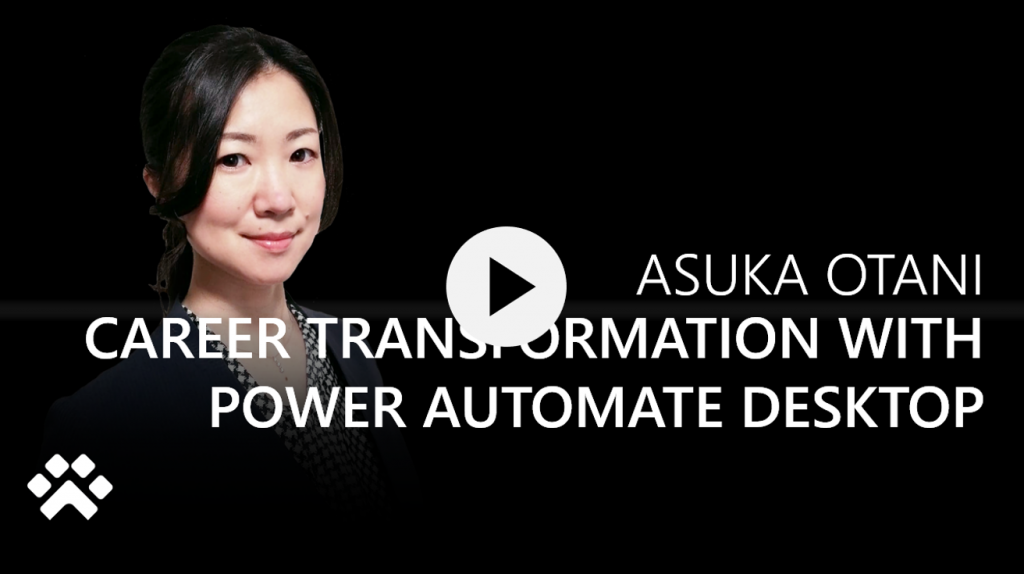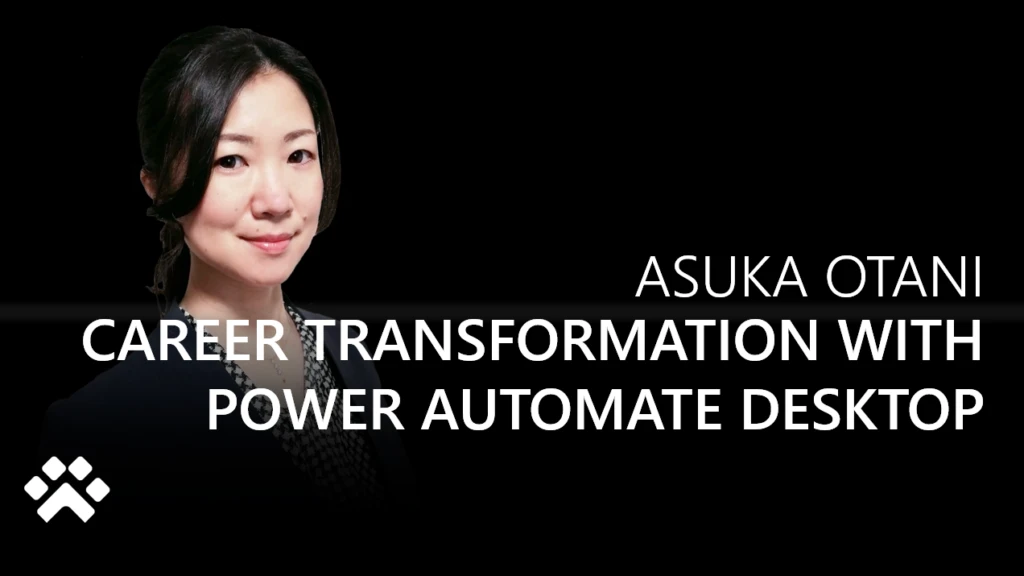
From HR to evangelist – career transformation using Microsoft Power Automate Desktop
Microsoft Power Platform has been a service to cater for all developers – citizen developers, pro developers, IT professionals, etc. Today, we share a story from Japan, a career transformation journey with Microsoft Power Automate Desktop.
Meet Asuka Otani

Before Asuka embarked her RPA journey in 2018, she had been on a back office role for 16 years in the human resources and general affairs department of a manufacturing company in county of Aichi, with no IT background. Her work involved a lot of manual work – sealing stamps, sending Faxes, making phone calls and other paperwork. She did not even have her own designated computer to work with.
As work accumulated, she found herself often ending up working at the office after hours. Her proposals of optimizing the work kept getting rejected. And what made the situation even harder for Asuka was that her little son also had to wait for her in the daycare because she had to work overtime. With all that was happening, she felt unconfident, self-doubting and low self-esteem. Just when she felt she was hitting the rock bottom, she was about to start a new adventure, which was going to transform her career completely.
How her RPA journey began
In exploring ways to improve work efficiency, Asuka found an online article about Robotic Process Automation, which got her interested. She looked online and viewed more videos on how to automate with RPA, and she realized how intuitive it was for non-technical person to begin using RPA as all of the actions were with names that anyone could understand.
She had initially tried learning also from online forums for RPA, but still had no idea what people on the forum were talking about. The more she studied, the more isolated and lonely she felt. Using that as fuel for motivation, she then turned to Twitter.
“I found people through Twitter and the RPA communities, who were in the similar situation and skillsets like me. That’s where I started exchanging ideas with one another. I even found people who quickly became like my soulmates. There were many people in the community who wanted to change how they were working through RPA. It encouraged me, and also expanded my vision too.”
Realizing the opportunity, Asuka was committed to making the changes she’d wanted in with RPA. No one else in her company had knowledge about RPA, so she started self-teaching by learning from dozens of books she bought.

Her company did have understanding of importance to invest in IT, and approved her to use up to 900 dollars to try RPA out. Asuka sat down with her colleague to discuss the processes that they wanted to automate on, and prioritized what they felt was the most stressful for them. Some of the automations that they did through RPA was:
- Sending PDF documents to over a hundred customers
- Retrieving manufacturing results and aggregating by each department for reporting
- Emailing employees who had forgotten to register their time on timesheet management system

By implementing RPA automations, she managed to reduce work from 200 hours to just one click of a button by automating 10 of her tasks.
“When I showed my colleagues the automation, they were really amazed because they knew me as a non-technical person.”
Struggles during COVID-19
Despite the success she got in automating creation of manufacturing reports and customer invoicing., she was informed by the company to terminate the RPA licensing as other higher investment priorities came after COVID-19 hit Japan and impacted the company’s financial situation. She thought of even quitting the job, until her colleague told her:
“You have tried so hard up to now to automate your work through RPA. You shouldn’t just give up! It was you, who made us realize that we should be automating our work through IT.”
So, she started to look for alternatives where her current employer ASAHI Accounting Robot Research Institute – a Microsoft Partner for Power Automate replied back to her Twitter that there is another less expensive RPA – WinAutomation (Now known as Power Automate ).
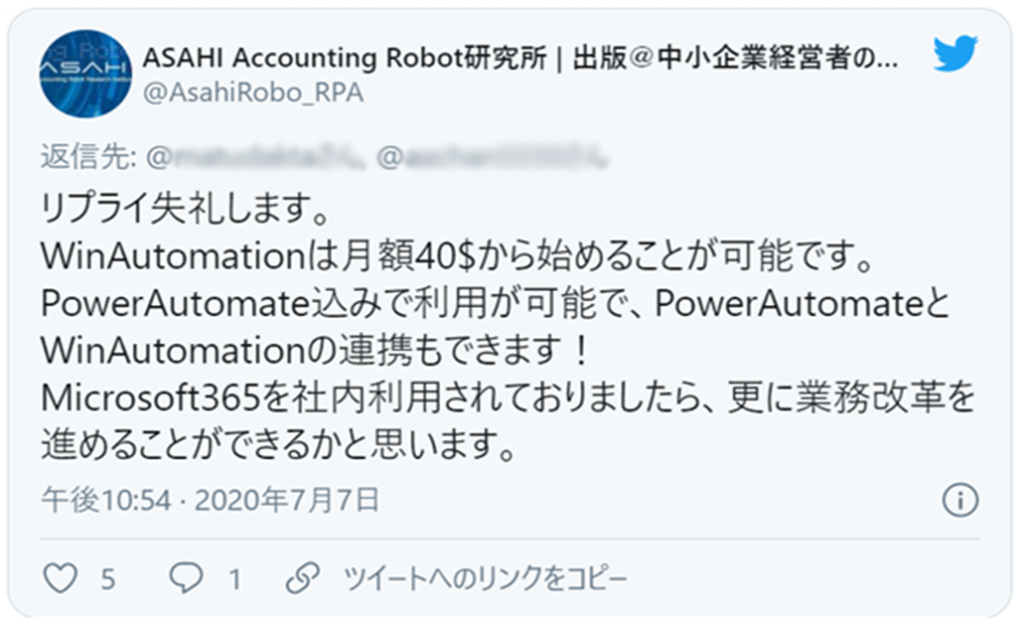
Asahi Accounting Robotics replies on Twitter to Asuka about Power Automate:
“WinAutomation (now Power Automate Desktop) allows you to start at $40 per month. It includes Power Automate, and you can also link with Power Automate (cloud flows). If you already have Microsoft 365, you can further transform the way you work.”
Starting over with Power Automate Desktop
Asuka once again started the RPA journey, and learned Power Automate Desktop from zero. She struggled with the differences from the old RPA to this new one. At the time, WinAutomation was only available in English (now provided with dozens of other languages including Japanese) which made it even more difficult for Asuka but also saw some pleasant new learnings.
“I signed up for an e-learning service to learn about Power Automate Desktop. Although it was hard in the beginning because of the differences, I then also learned new features like For Each loops which I couldn’t do before and I immediately saw the potential possibilities which I could automate, and I realized I can do a lot more than I previously could through Power Automate Desktop.”
In addition to the book, she also went further to sign up for online chat support, which helped her upskill in Power Automate Desktop quickly in three months.
“I was surprised by myself for how much I could learn and accomplish in matter of three months. RPA is like just building blocks. All the names are easy for me to understand, like “Launch Excel” or “Start up application”. Although I didn’t have the skills to do coding, I felt I could ramp up with RPA easily.”
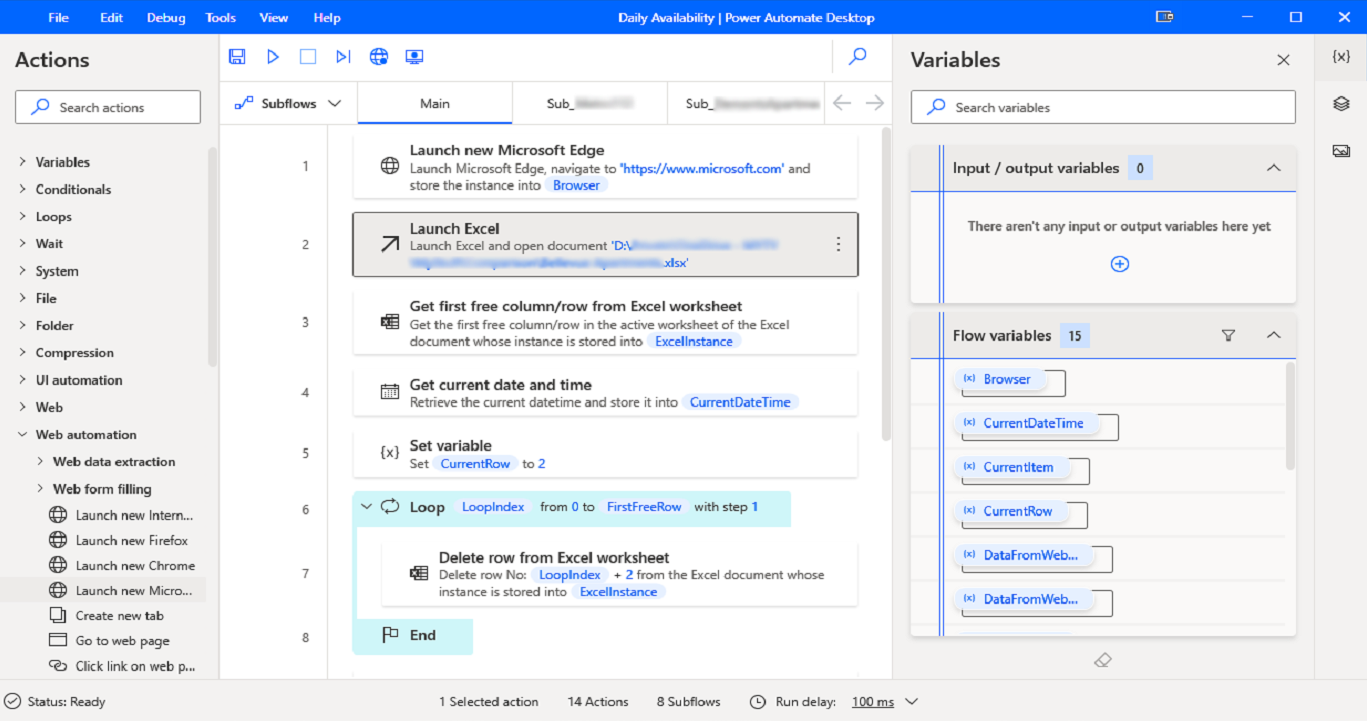
Actions have names that are easy to understand for anyone
After three months of trying out Power Automate Desktop, she had a good understanding of things like For Each, and was even able to customize the UI elements on her own for more complex scenarios.
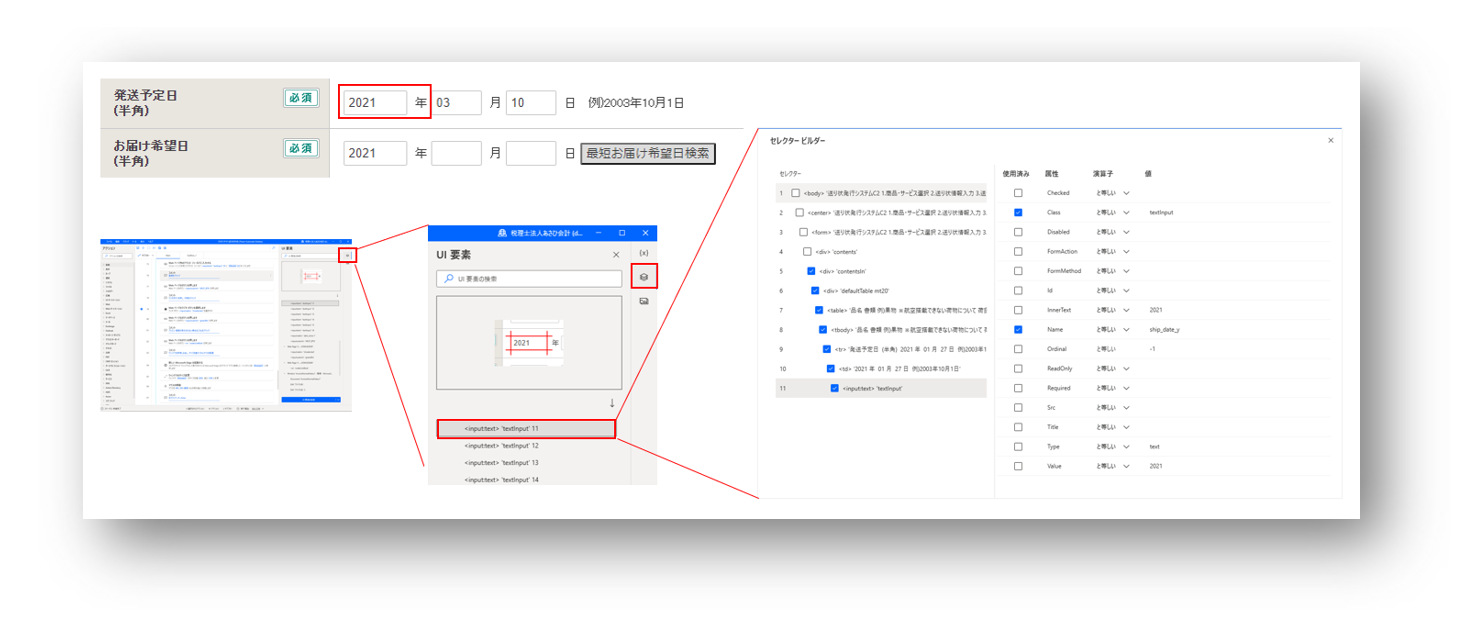
Diagram showing how Asuka used the UI selector
New opportunity via single tweet
Despite all the accomplishments, Asuka was frustrated because no one in her company fully understood the value of her work. She didn’t have her own computer, the company didn’t appreciate her efforts, she one day from the toilet tweeted:
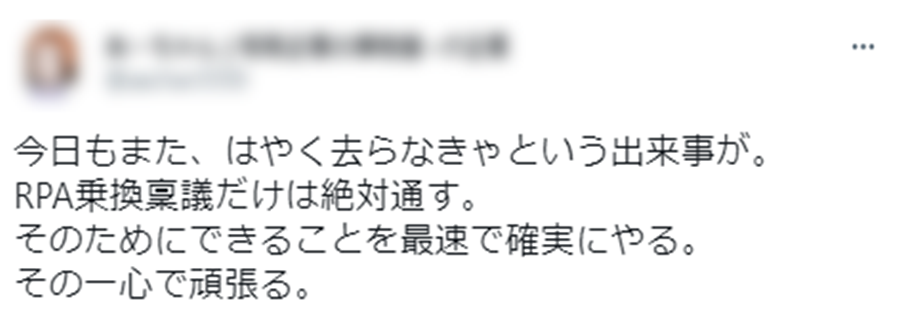
“Today, I felt I should leave this company as soon as I can.
But before I leave, I’m going to get my RPA approved.
I’m going to get this done as soon as I can. This is my only hope.”
This tweet caught attention from ASAHI Accounting Robot Research Institute. They had followed Asuka on Twitter as she shared her thoughts and learnings about how to implement RPA in a small/mid-size business. Asahi asked if she wanted to have a chat with them. After discussion, Asuka was offered a position to work there fully remote – as her home was over five hundred miles away from the company’s office.
Contributing to the community
Asuka has always felt that there are many people out there in the world, who is in the similar situations like hers, where they would not know how to improve their work or realize the opportunity RPA could provide, so she tries to contribute as much as she could to the community.
“I shared my experience telling the community through presenting at events and through Twitter that I was just an office worker in HR, but I could transform the company through Power Automate Desktop. Not only did I change that, but it also changed my career journey. People reached out to me after presenting saying how they felt empowered and that really made me happy.”
New role, new business card
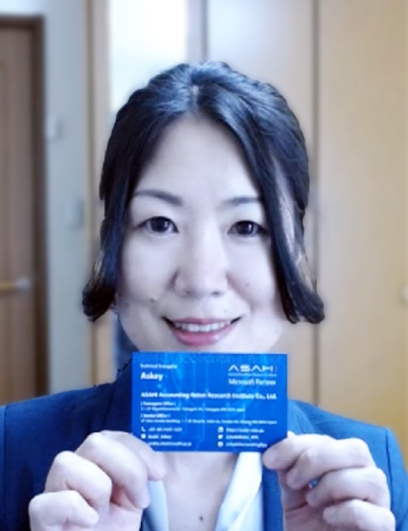
When Asuka first onboarded in Asahi, she was asked to commit on becoming an engineer. It was sometimes difficult for her to understand what her new colleagues were talking about as they come from different backgrounds, but surprise awaited her.
“A pack of business cards arrived my home, and when I opened it, my title was “Technical Evangelist”. I felt the title suggested the company doesn’t just expect me to become an ordinary RPA engineer, but together, use my past experiences as an end user and share how fun it is to transform work through Power Automate Desktop, and also understand the pain and support the end-users when implementing this. It was a new role in the company, made just for me.”
With her new role, she presents at webinars (online seminars) focusing on people in HR and general affairs role on how they could change the way they work using Power Automate and Power Automate Desktop. One of the things she has created is an employee welfare check system built with Power Automate Desktop. Since Japan often suffers from earthquakes, the system would send email notifications to employees in case of an earthquake to gather the latest situation of each employee by collecting results using Microsoft Forms, consolidate them to Excel online, and send support if necessary.
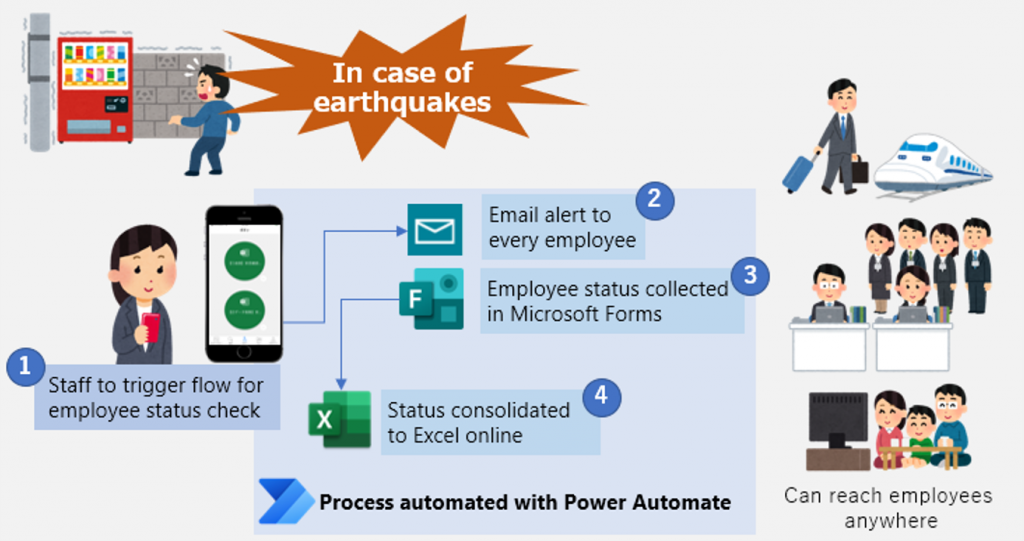
“It was important to make the solution using cloud services like Power Automate, as if the system was on-premise, the servers could face issues from the damage during the earthquake. I now distribute this as a template to my customers, so that they can immediately see the kind of value Power Automate has. I could only think of this idea because I was in HR.”
With experiences as an HR professional and now specialized role in RPA, she hopes to expand her contribution.
“I’m starting to understand better on the technical side of things now, so I hope to act as a bridge across end users and professional developers as citizen developer. I have many ideas in my head, and now, I need to make them into real life solutions.”
Message to the world
With her career transformation story, she gave the message to the world, aimed to those who also wants to change their careers through Power Automate Desktop:
“As I began as an end user at my previous company and started worked on implementing RPA, people from the community, from Twitter all supported me throughout my journey to transform the company I was in. And despite I was in this not well-known company, I am telling this experience to the world and that made me feel that the person who seriously try and achieve something can empower others, and that experience becomes a great power. This was an amazing experience for me so what I would like to tell everyone is, is that there is this amazing tool called Power Automate Desktop – a tool that even office workers can use.
I would like everyone to try using the tool and pass on to your colleagues what you experienced. I’ve used this tool for two years, and it was amazing to see my colleagues also changing along with me. So try transforming your company with Power Automate Desktop and there are even opportunities like I had, to transform careers too. I hope everyone uses this more.”
Interview available in Power CAT Live
Want to know the whole story? You can watch the interview with Asuka on Power CAT Live!

